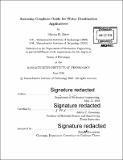Assessing graphene oxide for water desalination applications
Author(s)
Dave, Shreya H
DownloadFull printable version (17.29Mb)
Alternative title
Assessing GO for water desalination applications
Other Contributors
Massachusetts Institute of Technology. Department of Mechanical Engineering.
Advisor
Jeffrey C. Grossman.
Terms of use
Metadata
Show full item recordAbstract
Water desalination plays a critical role in augmenting the fresh water supplies for water scarce regions. However, despite considerable improvements in system efficiencies, it still remains six to ten times more expensive than treating freshwater for drinking. As a result, the construction and operation of a desalination plant places considerable economic burden on the regions that require such an investment. As more and more regions experience water stress due to climate change, increased industrial consumption, and population growth, materials engineering will play a role in improving the economics. The membranes used in today's reverse osmosis plants are made from polymers that are fragile, limited in the flux, and typically operate at 70% of their rated performance due to biofouling. Following the exciting proposition of using graphene as a size-exclusion based desalination membrane, there has been a great deal of revived interest in the development of new membrane materials that overcome these challenges. Graphene oxide, made from the chemical exfoliation of graphite, has served as a promising candidate for membrane applications because it is cheaper than graphene to produce and yet demonstrates similar benefits of resilience and increased permeability. In this work, we take a critical look at three aspects of graphene oxide as it applies to the development of water desalination membranes. First, we present an atomic study of the structure of graphene oxide (GO) that is produced in bulk quantities. In contrast to previous work, which has examined particularly defect free GO, we find that GO develops a nanocrystalline structure in support of a Dynamic Structural Model in its hexagonal carbon lattice. Second, we detail the development of a new cross-linker that enables the fabrication of stable GO films with sub-nanometer interlayer spacing and demonstrated nanofiltration performance. The process of cross-linking and membrane fabrication is entirely solution based and therefore promising for scale up. Finally, we evaluate the techno-economic feasibility of a GO as a water desalination material with a comparison between estimated production cost and savings in terms of the levelized cost of water. We quantitatively assess GO membranes as a scalable technology and identify other separation areas that could be served by robust membrane materials. With these three diverse analyses, I aim to provide a research-based perspective as to the material system, technological hurdles, and the economic potential of graphene oxide membranes.
Description
Thesis: Ph. D., Massachusetts Institute of Technology, Department of Mechanical Engineering, 2016. Cataloged from PDF version of thesis. Includes bibliographical references (pages 121-133).
Date issued
2016Department
Massachusetts Institute of Technology. Department of Mechanical EngineeringPublisher
Massachusetts Institute of Technology
Keywords
Mechanical Engineering.